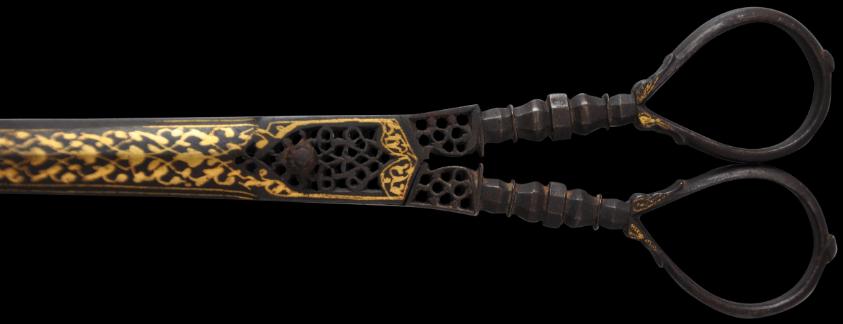
Islamic Persian Steel Calligrapher’s Scissors
Gold-Damascened Steel Calligrapher’s Scissors
Persia/Iran
late 18th century
length: 26cm, weight: 86g
Gold and silver-inlaid calligrapher’s scissors from nineteenth century Istanbul and elsewhere in Ottoman Turkey are relatively common. But damascened calligrapher’s scissors from eighteenth century Persia or Iran with the open-work that is characteristic of Persian steelwork are much rarer.
This pair of scissors from eighteenth century Persia is of chiselled steel. The handles are of elegant tear-shaped form with baluster-chiselled twines that lead to an extremely refined open-work section and then to the long, concave blades.
The blades are damascened with gold in trellised foliage patterns. The handles also have a small amount of gold damascene. It is unusual in Persian calligrapher’s scissors to have both open-work and gold damascening. Usually one or the other form of decoration is present.
Korans and indeed any other books or documents had to be written by hand prior to the advent of Arabic typeset. Scissors such as these were part of the calligrapher’s tools of trade. They were used to cut paper sheets to the correct size prior to binding. Such scissors were used to cut only the finest paper. Thicker paper was cut using shears.
Iran has a long history of steel production. Steel – iron smelted with a small quantity of carbon – is much harder than iron and so is ideal for the manufacture of swords and lances. The
Shah-nameh, the ‘Book of Kings’, the enormous Persian poetic epic written around 1000AD, contains the story of Jamshid who moulded iron or steel into helmets, chain-mail, swords, horse armour and the like. Later, Isfahan became an important centre for the production of small, high-quality steel items. According to Allan (2000, p. 13) there was a guild in Isfahan that comprised swordsmiths, cutlers, scissor-makers, chain-mail makers, helmet makers and Koran-case makers. Other guilds were responsible for the manufacture of other types of steel items.
Provenance
UK art market.
References
Allan, J.W., Persian Steel: The Tanavoli Collection, Yassavoli Publications, 2000.
McWilliams M. & D. Roxburgh,
Traces of the Calligrapher: Islamic Calligraphy in Practice c. 1600-1900, Museum of Fine Arts, Houston, 2007.
Melikian-Chirvani, A.S.,
Le Chant du Monde: L’Art de l’Iran Safavide 1501-1736, Somogy Editions D’Art, 2007.
Savage-Smith, E.,
The Nasser D. Khalili Collection of Islamic Art: Science, Tools & Magic, Part Two: Mundane Worlds, The Nour Foundation, 1997.
Inventory no.: 1409
SOLD





